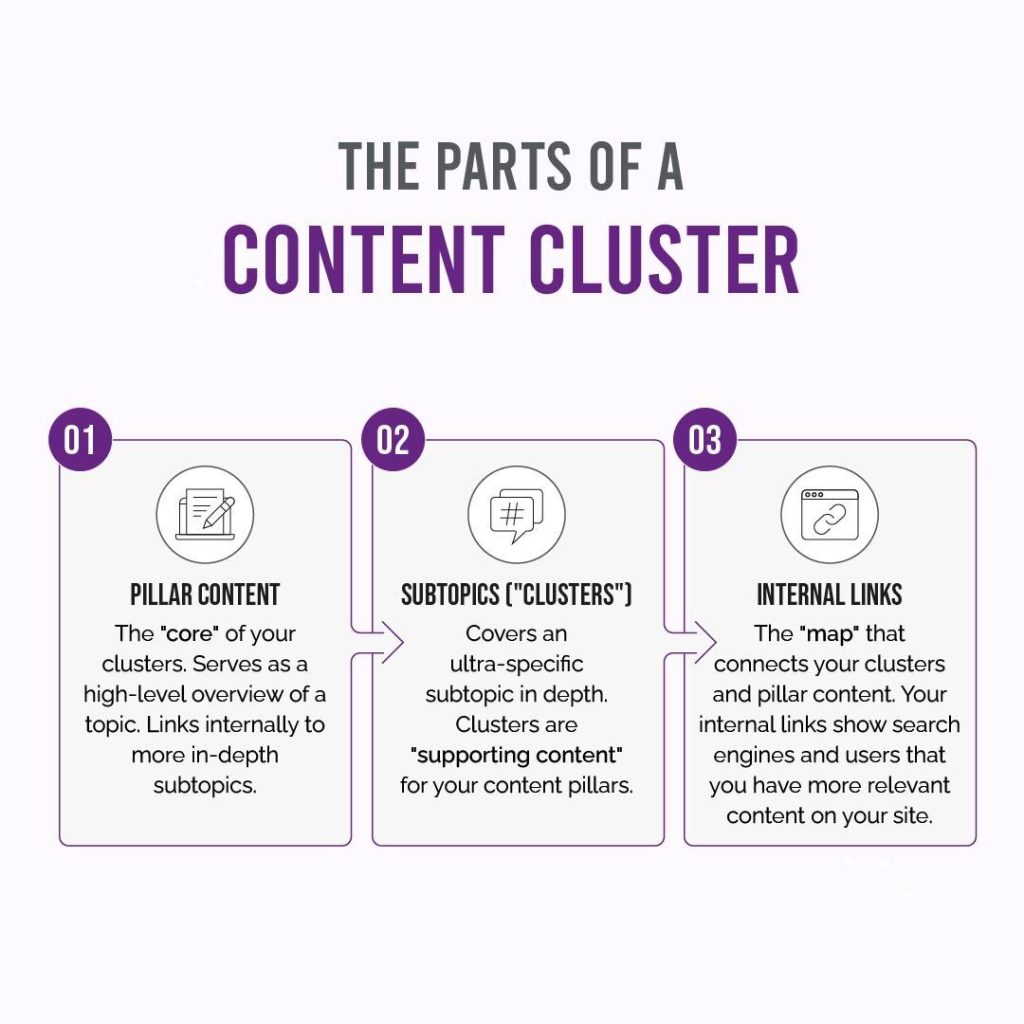Updated August 13, 2024
Content clusters, also known as the hub-and-spoke content model or topic clusters, can help you drive traffic to your website and create a more streamlined user experience.
Clusters are a key part of your content strategy. Let’s take a deeper look into what content clusters are, why they’re crucial to SEO, and how you can create topic clusters in 7 easy steps.
What are Content Clusters?
Topic clusters are groups of related content that help search engines and users navigate your site and provide comprehensive information about a topic.
And if your content is comprehensive enough, content clusters help ensure that your website visitors never have to return to Google search results to get the answers they’re searching for.
Topic clusters are made of three components:
- Pillar content on a core topic
- Subtopics (these are your “clusters”)
- Internal links

Let’s break down each of these parts of a content cluster even further:
What is Pillar Content?
When creating topic clusters, you need to create what is called “pillar” content.
Pillar content is a catch-all for a variety of user intents. Your pillars serve as a core piece of content on your website that gives concise answers to every question someone might have about your topic. Your pillar content doesn’t cover everything in depth, but rather gives a high-level overview of the topic.
Your more in-depth information goes in your clusters.
What are Subtopics (or “Cluster” Content?)
Cluster content is supporting content that has a more specific purpose. If your content was a book, your pillar content would be a glossary while your clusters are chapters.
Your cluster content will go in-depth on a very specific subtop of your main topic.
Internal Links
Internal links are what ties your content clusters together.
If we’re sticking with the “book” analogy, if your pillar content is a glossary and your clusters are chapters, your internal links are the plotline.
Your internal links connect your clusters together. You will have links from your pillar content to your clusters, and your clusters will link to each other. You might also have links back to your pillar content if it’s applicable.
You do this through something called contextual linking, which shows search engines and users that you have other related content on your website and that’s where they should go next.
When all of these pieces are in place, Google (and users) understand better how to navigate your content, which means a better user experience and better search engine rankings.
Why You Need to Create Content Clusters
Content clusters, as mentioned above, help you provide comprehensive information about a specific topic. This is important for a several reasons:
Search Engines are Better Able to Understand Your Website
Content clusters indicate to search engines that you provide comprehensive information on your topics. Because you go in depth on topics and subtopics, search engines are able to determine contextually what your website is about.
Content Clusters Build Topical Authority
With cluster content, you have the opportunity to build topical authority. The more information you cover on a specific topic on your website (given that it’s accurate, cohesive, comprehensive, and well-written), the more Google looks at your site as an authority on the subject.
A good way to think about it is that Google wants your content to be basically its own encyclopedia on the subject.
Content Clusters Tell Search Engines What Pages are Most Important
Content clusters help search engines determine the hierarchy of each page on your website within a group of content.
As search engines crawl your site, they can determine this hierarchy through the “map” of your internal links. The more internal links to a specific page, the more “important” it will seem to search engines.
Content Clusters Help You Dominate Keyword Groups (and Avoid Cannibalization)
Keyword groups are groups of closely related keywords. Keywords from a specific group can be distributed across your content clusters. Each of your pages will have a specific focus keyword and topic, meaning less of a chance to cannibalize your pages.
And–this is important–the quality of your content is crucial in SEO. Each of your clusters needs to be comprehensive, thorough, written for user intent, and overall useful to search engine users. Writing using your specific keywords isn’t enough. The quality has to be there.
Better User Experience
Users are better able to find the answers they’re looking for because your relevant content is linked together. This means no hitting the “back” button to go back to search results and ending up on your competition’s website.
Increased Conversions
When you implement content clusters, page dwell time increases, which leads to better conversions.
This is how that works:
A search engine user types in a search query→ the user lands on your website → your content links them to other relevant content that answers even more of their questions → you begin to build the know, like, and trust factor with your the users → the user sees your expertise and the value your offer → the user navigates to a sales page where a conversion is made.
At the end of the day, Google and other search engines care more about providing the best and most helpful content to their users. The easier your site is to navigate and the better your content, the more search engines will put your content in front of their users.
How to Create Topic Clusters in 7 Steps
Creating topic clusters sounds more challenging than it is. While the process isn’t quick–and it is a little tedious–creating your clusters can be done in 7 simple steps.
1. Conduct Keyword Research
Keyword research is the core of creating your topic clusters. If you want to dominate keyword groups, you need to know–in detail–what those keywords are.
To conduct keyword research, you can use a tool like Ahrefs keyword explorer to find popular keywords, determine keyword difficulties, and view the traffic potential of each keyword. The Ahrefs keyword explorer tool can help you determine related keywords and create your keyword groups.
2. Identify Your Pillar Content & Clusters
Once you’ve determined your keyword groups, it’s time to identify your pillar content and content clusters.
To do this, you need to know something about your buyer persona. What is your ideal customer searching for?
For example, Amplihigher is a copywriting and content agency. For our pillar content, the “content marketing” is far too obtuse and “how to write a blog for your website” is too specific for pillar content. But “SEO Content Writing FAQ” is broad enough that we could link out to more specific subtopics and specific enough that it attracts our ideal audience: business owners looking for SEO content writers.
So, an example of a content cluster would be “SEO Content Writing FAQ” as the pillar, with subtopics such as content clusters (what you’re reading right now), contextual linking, types of keywords, and how to choose your pillar content.
Let’s put it into a visual example:

If you’re just getting started with creating content clusters, choose four or five core services or topics that your company focuses on and build from there.
If you’ve already got a good amount of content on your site, you may already have potential pillar content and clusters created.
Which brings us to…
3. Audit & Map Your Current Content
Before you create new content for your clusters, it’s a good idea to conduct a content audit and clean up your current assets
Go through each piece of content on your website and ask yourself the following questions:
- Is this piece of content relevant to my current services?
- Does this content provide actionable, thorough information?
- Does this content need to be updated?
- Does this content get any traffic?
- Is this content currently ranking for any of my desired keywords?
- Is there other very similar content on my site that I could combine with this to make more comprehensive content?
- Does this piece of content have enough visuals to keep the audience engaged? (think tables, video, and graphics)
- Is this content optimized for readability? (think bucket brigades, bullet points, numbered lists, and the proper use of headers)
- Is this content well-written?
Purge any irrelevant content from your site and make note of any content that can be merged with other content (such as two articles covering the same topic) or updated to meet current Google algorithm standards.
Look for any content that is “pillar material.” You can utilize this now and make it more comprehensive when we get to step 6.
Once you’ve done a deep-dive of your existing content, it’s time to make connections and create your clusters. Hyperlink your clusters to your pillar piece and other clusters where applicable. Make sure you link to all of your clusters from your pillar content.
And, it should go without saying that when you link to your clusters that you should use contextual links.
4. Identify Content Gaps
Now your existing content has been turned into your baseline clusters. Now, you will identify any content gaps. Content gaps are the “missing pieces” of what users are seeking out as compared to the results they receive.
You’re creating your content clusters because you want to generate real, qualified traffic to your site. To do this, you need to create content that people are actively searching for. This means answering common questions.
If you can determine questions that people are asking that you don’t have answers to on your site, create clusters around those questions.
5. Create Your Content Strategy
Now it’s time to create the strategy behind updating your existing content to maximize your pillars and subtopics.
If you’ve already mapped your website’s current content to connect your pillars to your subtopics (and vice versa) you can now strategize your new content calendar.
If you have five pillars on your website, and you want 12 supporting subtopics, you don’t want to publish these in their separate chunks.
You will want to create a content cluster schedule that “drips” your content over time.
For example, your content cluster calendar might look something like this over a 12 week period:
| Week | Pillar #1 | Pillar #2 | Pillar #3 | Pillar #4 | Pillar #5 |
| 1 | Cluster Topic | ||||
| 2 | Cluster Topic | ||||
| 3 | Cluster Topic | ||||
| 4 | Cluster Topic | ||||
| 5 | Cluster Topic | ||||
| 6 | Cluster Topic | ||||
| 7 | Cluster Topic | ||||
| 8 | Cluster Topic | ||||
| 9 | Cluster Topic | ||||
| 10 | Cluster Topic | ||||
| 11 | Cluster Topic | ||||
| 12 | Cluster Topic |
Above: example cluster content calendar
This way, you’re publishing a variety of content on your site for your audience and you’re building your clusters simultaneously.
Then, each time you post a topic cluster, go back to your pillar content and ensure that you’re linking to it, updating your pillar content with new information as necessary.
6. Write Your Content
Once you know what you’re going to write, now you need to actually write the content (or hire a content writing agency to do it for you).
To write your content in a way that’s most conducive to your SEO strategy, you need to be familiar with the latest search engine algorithm updates (particularly Google), understand how to structure your content, and know what both search engines and users want to see.
Back in step three we talked about a few things that make content really, really good (go back and read those last 3 bullets).
Your content needs to utilize visuals to keep your audience engaged, optimize the page for readability, and make sure the content you publish is exceptionally well-written. Google values quality content above all else. If you can incorporate these three elements into your content, you’ll be pleasantly surprised at how well it performs.
7. Link Your New Content
Once your content is written, make sure you are using internal linking correctly. When you publish your content, make sure the internal links you use are to other pieces of related content–that is, other content within your cluster.
And–this cannot be overstated–go back to both your pillar content and your other supporting content and add a link to your new subtopic content.
By linking to and from every piece of content in your cluster, you create a “web” that is easily crawled by search engines and easily navigated by users.
Creating Content Clusters for Maximum Search Engine Visibility
Content clusters aren’t just changing the game for SEO content writers–they make the rules.
If you want your website to scale the ranks of search engines and attract qualified leads, creating and maintaining your content clusters helps your website compete–and win.






